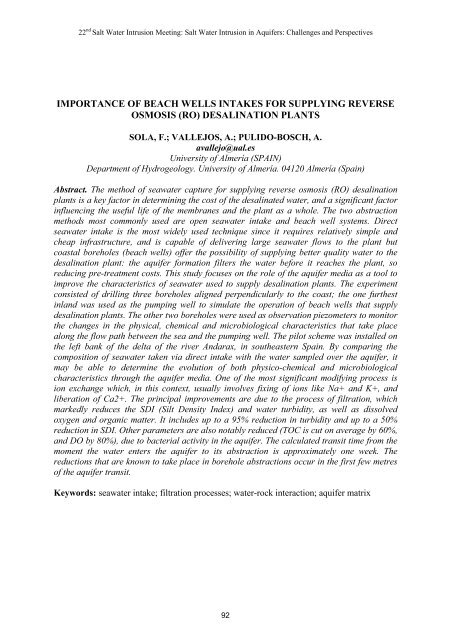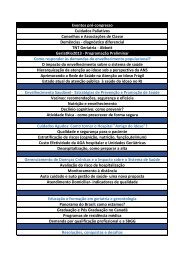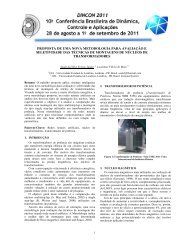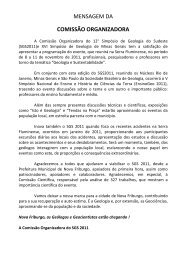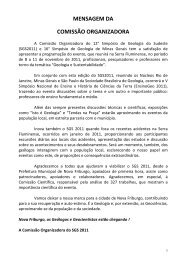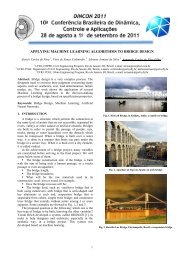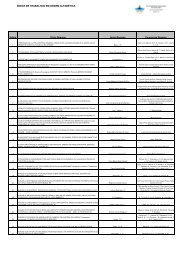- Page 3 and 4:
SWIM22 - 22 nd Salt Water Intrusion
- Page 5 and 6:
Local Supporting Organizing TeamMar
- Page 7 and 8:
Peter StuyfzandKiwa Water Research,
- Page 9 and 10:
PrefaceWelcome to the 22 nd Salt Wa
- Page 11 and 12:
SUMMARYKeynote Lectures pg 13Coasta
- Page 13:
Groundwater hypersalinization in a
- Page 16 and 17:
Hydrostratigraphic Study of Itaipua
- Page 18 and 19:
Keynote Lectures
- Page 20 and 21:
22 nd Salt Water Intrusion Meeting:
- Page 22 and 23:
22 nd Salt Water Intrusion Meeting:
- Page 24 and 25:
22 nd Salt Water Intrusion Meeting:
- Page 26 and 27:
22 nd Salt Water Intrusion Meeting:
- Page 28 and 29:
22 nd Salt Water Intrusion Meeting:
- Page 30 and 31:
22 nd Salt Water Intrusion Meeting:
- Page 32 and 33:
22 nd Salt Water Intrusion Meeting:
- Page 35:
Effects of sea levelrise and climat
- Page 38 and 39:
22 nd Salt Water Intrusion Meeting:
- Page 40 and 41:
Hans Sulzbacher 1 ; Helga Wiederhol
- Page 43:
Resistivity [Ωm]0.1 1 10 100 10000
- Page 46 and 47:
22 nd Salt Water Intrusion Meeting:
- Page 48 and 49: 2. METHODS Figure 1a.
- Page 50 and 51: 4. DISCUSSION AND CONCLUSIONSREFERE
- Page 52 and 53: 22 nd Salt Water Intrusion Meeting:
- Page 55 and 56: 22 nd Salt Water Intrusion Meeting:
- Page 57 and 58: METHODS 51
- Page 59 and 60: DISCUSSION AND CONCLUSIONS
- Page 61 and 62: 22 nd Salt Water Intrusion Meeting:
- Page 63 and 64: 22 nd Salt Water Intrusion Meeting:
- Page 65 and 66: 22 nd Salt Water Intrusion Meeting:
- Page 67 and 68: 2. RESULTS, HOW TO GET THERE AND WH
- Page 70 and 71: STUDY OF THE SALTWATER-FRESHWATER I
- Page 73 and 74: 4. DISCUSSION5. CONCLUSIONS67
- Page 75: Hydrogeochemical and isotopicmethod
- Page 78 and 79: 22 nd Salt Water Intrusion Meeting:
- Page 80 and 81: Figure 1 Location map of study area
- Page 82 and 83: Therefore, it was clarified that th
- Page 84 and 85: 22 nd Salt Water Intrusion Meeting:
- Page 86 and 87: 22 nd Salt Water Intrusion Meeting:
- Page 88 and 89: GROUNDWATER HYPERSALINIZATION IN A
- Page 90: 3. RESULTS AND DISCUSSIONS
- Page 93 and 94: 22 nd Salt Water Intrusion Meeting:
- Page 95 and 96: 2 nd Salt Water Intrusion Meeting:
- Page 97: 2 nd Salt Water Intrusion Meeting:
- Page 104 and 105: 22 nd Salt Water Intrusion Meeting:
- Page 106 and 107: 22 nd Salt Water Intrusion Meeting:
- Page 108 and 109: 22 nd Salt Water Intrusion Meeting:
- Page 110 and 111: 22 nd Salt Water Intrusion Meeting:
- Page 113: Management of aquiferswith saline g
- Page 116 and 117: 22 nd Salt Water Intrusion Meeting:
- Page 118 and 119: 22 nd Salt Water Intrusion Meeting:
- Page 120 and 121: 22 nd Salt Water Intrusion Meeting:
- Page 122 and 123: 22 nd Salt Water Intrusion Meeting:
- Page 124 and 125: 22 nd Salt Water Intrusion Meeting:
- Page 126 and 127: 22 nd Salt Water Intrusion Meeting:
- Page 128 and 129: 22 nd Salt Water Intrusion Meeting:
- Page 130 and 131: 22 nd Salt Water Intrusion Meeting:
- Page 132 and 133: 22 nd Salt Water Intrusion Meeting:
- Page 134 and 135: 22 nd Salt Water Intrusion Meeting:
- Page 136 and 137: 22 nd Salt Water Intrusion Meeting:
- Page 138 and 139: 22 nd Salt Water Intrusion Meeting:
- Page 140 and 141: 1. INTRODUCTION 134
- Page 142 and 143: 5. ARTIFICIAL RECHARGING TECHNIQUES
- Page 144 and 145: 22 nd Salt Water Intrusion Meeting:
- Page 146 and 147: 22 nd Salt Water Intrusion Meeting:
- Page 148 and 149:
22 nd Salt Water Intrusion Meeting:
- Page 150 and 151:
144
- Page 152 and 153:
146
- Page 154 and 155:
PRELIMINARY EVALUATION OF SALINE IN
- Page 156 and 157:
3.2 Laboratory results 3.
- Page 158 and 159:
22 nd Salt Water Intrusion Meeting:
- Page 160 and 161:
22 nd Salt Water Intrusion Meeting:
- Page 162 and 163:
22 nd Salt Water Intrusion Meeting:
- Page 164 and 165:
22 nd Salt Water Intrusion Meeting:
- Page 166 and 167:
22 nd Salt Water Intrusion Meeting:
- Page 168 and 169:
22 nd Salt Water Intrusion Meeting:
- Page 170 and 171:
22 nd Salt Water Intrusion Meeting:
- Page 172 and 173:
22 nd Salt Water Intrusion Meeting:
- Page 175 and 176:
22 nd Salt Water Intrusion Meeting:
- Page 177 and 178:
22 nd Salt Water Intrusion Meeting:
- Page 179 and 180:
22 nd Salt Water Intrusion Meeting:
- Page 181 and 182:
22 nd Salt Water Intrusion Meeting:
- Page 183 and 184:
22 nd Salt Water Intrusion Meeting:
- Page 185 and 186:
22 nd Salt Water Intrusion Meeting:
- Page 187 and 188:
22 nd Salt Water Intrusion Meeting:
- Page 189 and 190:
22 nd Salt Water Intrusion Meeting:
- Page 191 and 192:
22 nd Salt Water Intrusion Meeting:
- Page 193 and 194:
22 nd Salt Water Intrusion Meeting:
- Page 195 and 196:
Figure 1: Resulting depth of the fr
- Page 197:
Figure 3: Development of the saltwa
- Page 201 and 202:
22 nd Salt Water Intrusion Meeting:
- Page 203 and 204:
1. INTRODUCTION2. GEOLOGICAL AND HY
- Page 205 and 206:
4. CONCLUSIONREFERENCES199
- Page 207 and 208:
22 nd Salt Water Intrusion Meeting:
- Page 209 and 210:
GROUNDWATER SALINIZATION IN THE COA
- Page 211 and 212:
3. ENVIRONMENTAL ISOTOPES3.1 Analyt
- Page 213 and 214:
22 nd Salt Water Intrusion Meeting:
- Page 215 and 216:
Jennifer Klimke 1 ; Gabriele Ertl 2
- Page 217 and 218:
211
- Page 219 and 220:
22 nd Salt Water Intrusion Meeting:
- Page 221:
22 nd Salt Water Intrusion Meeting:
- Page 225 and 226:
22 nd Salt Water Intrusion Meeting:
- Page 227 and 228:
22 nd Salt Water Intrusion Meeting:
- Page 229 and 230:
22 nd Salt Water Intrusion Meeting:
- Page 231 and 232:
22 nd Salt Water Intrusion Meeting:
- Page 233 and 234:
22 nd Salt Water Intrusion Meeting:
- Page 235 and 236:
22 nd Salt Water Intrusion Meeting:
- Page 237 and 238:
INTRODUCTION
- Page 239 and 240:
233
- Page 241 and 242:
22 nd Salt Water Intrusion Meeting:
- Page 243 and 244:
22 nd Salt Water Intrusion Meeting:
- Page 245 and 246:
22 nd Salt Water Intrusion Meeting:
- Page 247 and 248:
22 nd Salt Water Intrusion Meeting:
- Page 249 and 250:
22 nd Salt Water Intrusion Meeting:
- Page 251 and 252:
22 nd Salt Water Intrusion Meeting:
- Page 253 and 254:
22 nd Salt Water Intrusion Meeting:
- Page 255 and 256:
22 nd Salt Water Intrusion Meeting:
- Page 257 and 258:
22 nd Salt Water Intrusion Meeting:
- Page 259 and 260:
Frans W. Schaars 1 ; Mark Bakker 2
- Page 261 and 262:
Figura 1255
- Page 263 and 264:
22 nd Salt Water Intrusion Meeting:
- Page 265 and 266:
259
- Page 267 and 268:
Figure 2. Computed density and mole
- Page 269 and 270:
22 nd Salt Water Intrusion Meeting:
- Page 271 and 272:
22 nd Salt Water Intrusion Meeting:
- Page 273 and 274:
22 nd Salt Water Intrusion Meeting:
- Page 275 and 276:
22 nd Salt Water Intrusion Meeting:
- Page 277 and 278:
22 nd Salt Water Intrusion Meeting:
- Page 279 and 280:
22 nd Salt Water Intrusion Meeting:
- Page 281 and 282:
22 nd Salt Water Intrusion Meeting:
- Page 283 and 284:
22 nd Salt Water Intrusion Meeting:
- Page 285 and 286:
22 nd Salt Water Intrusion Meeting:
- Page 287 and 288:
22 nd Salt Water Intrusion Meeting:


